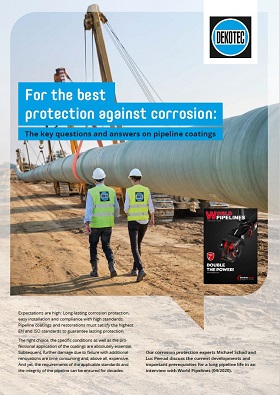Pipeline coating
- Sealing with experts

Corrosion protection is their area of expertise: Michael Schad and Luc Perrad answered the key questions on the topic of pipeline coatings in the leading international magazine World Pipelines.
How can cutting-edge coatings achieve corrosion resistance?
By definition, cutting-edge means something that the subject is the latest and newest development in the market. Related to coatings for large Oil & Gas pipelines, the latest and newest coatings are the following:
- Factory applied coatings:
- 3 layers Polyethylene (3LPE)
- 3 Layers Polypropylene (3LPP)
- Fusion Bond Epoxy (FBE)
- Field applied coatings:
- Field joints:
- 3 layers Heat Shrinkable Sleeves
- 3-ply Polyethylene-Butyl Rubber Tapes
- Liquid Coatings (e.g. Epoxies or Polyurethanes)
- Rehabilitation:
- Liquid Coatings (e.g. Epoxies or Polyurethanes)
- 3-ply Polyethylene-Butyl Rubber Tapes
- Field joints:
In general, each coating has to provide the best possible prevention against corrosion and has to guarantee a high level of mechanical protection to prevent the coating from damage.For field-applied coatings, we additionally have to consider ease of application, even under severe conditions on site (ambient temperatures, sand, surface contamination, etc.). Provided that coating systems meet the highest international standards; the best prove for coating systems is their ability to achieve corrosion resistance through long term experience. Their performance has been confirmed from the field after decades in operation, with good results regarding adhesion, water & oxygen-resistance, electrical insulation, cathodic disbondment resistance and mechanical strengths.
How does pipeline surface preparation and coatings application determine the success of coatings?
This question is related to field-applied coatings where application conditions are not fully controlled.
Surface preparation includes cleanliness (from dust, grease, etc.), surface profile (anchor pattern) and moisture (rain, fog or condensation):
- Cleanliness and moisture affect adhesion.
- Surface profile affects cathodic disbondment.
Coatings application conditions are depending on the coating type:
- Heat Shrinkable Sleeves need enough heat, including pre-heat and post heat, as well as avoiding trapped air under the sleeve.
- Liquid coatings need the correct mixing ratio, proper application thickness and enough curing between the different passes.
- 3-ply Polyethylene-Butyl Rubber Tapes need enough tension and constant overlap, both of which are generally easily secured by a manual or motorized wrapping machine e.g. DEKOMAT®-11.
Provided that coating systems meet the highest international standards; the majority of coating failures happening on site are not caused by intrinsic failure of material properties, but by improper surface preparation and inappropriate application of the coating. Therefore, we have to minimize the human impact on coating failures by developing easy-to-apply and failure-tolerant coatings. A coating system which can be corrected or adjusted during application (also with a machine) is most likely to be successful.
How do coatings influence flow efficiency?
This topic is, due to our knowledge, related to gas transportation pipelines. Internal coating (thin layer of liquid Epoxy curing by evaporation of solvents) is reducing friction between the internal wall of the pipeline and the transported gas. By using an internal lining of the pipe, flow efficiency can be raised by up to +20%. The internal lining will provide a smooth surface which will decrease turbulences and friction in the pipe significantly. As a consequence, pressure drops (or losses) along the pipe are also reduced which leads to a reduction in the number of compression stations along the pipeline route. The financial benefit from the reduction of compression stations largely compensates the costs of the internal coating, also called liner coating. The primary function of liner coatings is to facilitate product (gas) flow and not really to protect internal pipeline walls against corrosion. This is not the case for the transportation of crude oil, where bacterial attacks can happen inside the pipe and lead to corrosion. This phenomenon is called MIC (Microbiological Influenced Corrosion).
Detail some recent, innovative advancements being made in the pipeline coatings industry
As mentioned before, surface preparation is critical to ensure coating’s performance (mainly adhesion). Protecting the steel surface on the field from moisture (rain or fog) can be easily achieved by using adequate enclosures. However, removing the moisture coming from condensation of air humidity (substrate temperature below dew point) is much more difficult and can be very expensive. This typically happens on pipelines in operation when the temperature of the transported product is low. Many pipeline operators do not want to reduce or stop the transported product flow during coating application (loss of profit). They are also not ready to pay for completely sealing the job site in conditioned air.
Then, the most efficient alternative is to consider a coating system which can be applied on wet surfaces while guaranteeing the level of performance requested to protect the substrate against corrosion. This type of coating has been recently developed by combining the application of two tapes, a Petrolatum-Tape and a Polyethylene-Butyl Rubber Tape, which strongly bond to each other (and therefore show a cohesive failure during peel-test). On contrary to Epoxy coatings designed for wet surfaces, this new system does not need a grit blasting cleaning according to SA 2½.
Which international and national standards are important?
The answer is mainly dependent on the geographic location of the pipeline operators. In Europe, Africa, the Middle East and the Western part of Asia, international standards from EN and ISO organizations are mainly used. For coatings, the most relevant international standards are ISO 21809-3 for field joint coatings and ISO 21809-1/2 for mill coating of pipes. The European Standard EN 12068 is still renowned and very popular for field joints executed with tapes or heat shrinkable sleeves as this standard considers the practical aspects of different stress loads on site. In general, standards should all be stress-related and load case dependent, instead of a material-based selection only.
- In North America, NACE standards for Oil & Gas pipelines and AWWA standards for water pipelines are the most important.
- In Russia and the former CIS countries the GOST standards are the dominant ones.
National Standards are considered less and less.
How do you overcome coatings failures?
It is well-known and recognized in the pipeline coating industry that the majority of coating failures is the consequence of bad coating application conditions. Those conditions are generally related to surface preparation, weather conditions, condensation, salt contamination and the application being not in line with the manufacturer’s recommendations. Another reason for coating failure is the consequence of wrong coating selection: Parameters like pipeline operating temperatures, pipe diameter, backfill materials and mechanical impacts are critical in the selection of an appropriate coating system. The best way to overcome coating failures is to consider all those parameters indicated above.
How and why do you carry out pipeline coating rehabilitation?
Pipeline coating rehabilitation is necessary.
Pipeline coating rehabilitation should be considered when the existing coating compromises the integrity of the pipeline. There is no recognized rule or standard for defining coating conditions which might jeopardize the integrity of the pipeline. Each operator takes full responsibility to decide whether or not to rehabilitate the coating. This decision is influenced by economic and environmental factors: Coating rehabilitation for a water pipeline is not based on the same criteria as for a high-pressure transportation gas pipeline.
Major steps for pipeline coating rehabilitation:
- Pipeline section excavation.
- Existing coating removal.
- Surface preparation: surface profile and cleaning (dust, grease, salt).
- New coating application and curing.
- New coating inspection and eventual repair.
- Backfilling.
Pipeline rehabilitation is necessary when the mill coating gets weak or brittles after 30 to 35 years in service. Especially coal tar and bitumen coatings show the tendency to brittle and must be rehabilitated. After the old mill coating is removed by grit blasting or water jetting, the new coating can be applied in the field.
Preferably self-amalgamating 3-ply Polyethylene-Butyl Rubber Tapes are used for this purpose or liquid coatings based on Epoxy or Polyurethane. For the self-amalgamating tapes there are proven track records available dating back for more than 40 years in service. These pipe sections have been excavated and tested in laboratories and showed excellent results after this long service period: Even after more than 40 years they are exceeding the requirements of the current guidelines ISO 21809-3 and EN 12068 class C50 by far.
Discuss the current limitations of coatings technology
The ultimate coating system should be armed as a universal solution for all applications against all influencing factors - and it should also be easy to apply and at the same time exclude or at least significantly reduce the human error component. But is this even possible? So far, at least not, because a wide variety of influencing factors require correspondingly coordinated material properties. The ideal property of a product for one requirement may not be ideally suited for another requirement or another application. There are various requirements that a coating system must meet.
A coating’s aging or behavior over time is also an important limitation for all coating systems: Even if the coating shows excellent performances in its youth, it might weaken after certain years. It is therefore significantly important to choose the right coating which does not only promise to last but provides the respective proven track record in field for decades.
The selection of the right coating should be done according to stressable, objective data to evaluate the best system for the specific demands on site. Instead of focussing on (raw-) material properties of the coating system, the expected loads such as temperature, corrosion, mechanical impact, onshore/offshore, etc. should determine the choice of the right coating system.
These criteria should be surveyed by independent third parties. In addition, the applicators need regular trainings to fresh up on the newest application skills.
A chain is only as strong as its weakest link. This is also valid for the coating of a pipeline. The lifespan of a pipeline depends largely on the choice of the right field joint coating. For any new build pipeline the field joint coating only makes up a fraction of the total costs. Even in a rehabilitation of an existing pipeline the costs are significantly lower than building a new pipeline – especially considered the fact that the pipeline still can be in operation during rehabilitation works.
If the price of the (field joint) coating is pushed so far that only cheap and poor quality is used, the weak link of the chain gets even more weakened.
Thank you for the interview!
Contact – What can we do for you?
Do you have questions about products, system solutions or our company? Fill in our contact form. We are looking forward to hearing from you.
